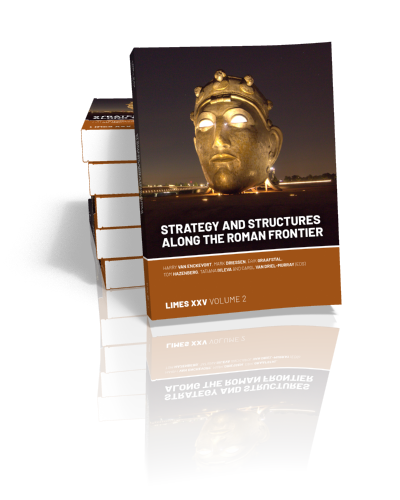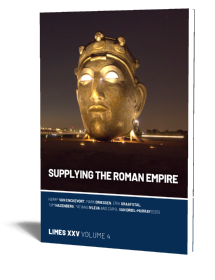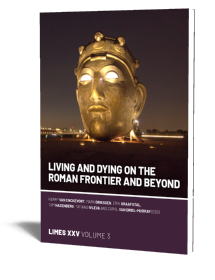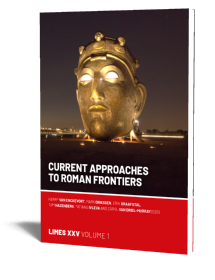Strategy and Structures along the Roman Frontier (LIMES XXV volume 2)
Proceedings of the 25th International Congress of Roman Frontier Studies 2
Edited by Harry van Enckevort, Mark Driessen, Erik Graafstal, Tom Hazenberg, Tatiana Ivleva and Carol van Driel-Murray (eds) | 2024

Strategy and Structures along the Roman Frontier (LIMES XXV volume 2)
Proceedings of the 25th International Congress of Roman Frontier Studies 2
Edited by Harry van Enckevort, Mark Driessen, Erik Graafstal, Tom Hazenberg, Tatiana Ivleva and Carol van Driel-Murray (eds) | 2024
Paperback ISBN: 9789464262780 | Hardback ISBN: 9789464262797 | Imprint: Sidestone Press | Format: 210x280mm | 462 pp. | Language: English | 43 illus. (bw) | 154 illus. (fc) | Keywords: archaeology; Roman Empire; Roman frontiers; limes; Roman armies; tribal identities; Roman fortresses; military installations; collapse; afterlife | download cover | DOI: 10.59641/ll634ox
Read online or downloaded 1107 times
-
Digital & Online access
This is a full Open Access publication, click below to buy in print, browse, or download for free.
-
Buy via Sidestone (EU & UK)
-
Buy via our Distributors (WORLD)
For non-EU or UK destinations you can buy our books via our international distributors. Although prices may vary this will ensure speedy delivery and reduction in shipping costs or import tax. But you can also order with us directly via the module above.
UK international distributor
USA international distributor
-
Bookinfo
Paperback ISBN: 9789464262780 | Hardback ISBN: 9789464262797 | Imprint: Sidestone Press | Format: 210x280mm | 462 pp. | Language: English | 43 illus. (bw) | 154 illus. (fc) | Keywords: archaeology; Roman Empire; Roman frontiers; limes; Roman armies; tribal identities; Roman fortresses; military installations; collapse; afterlife | download cover | DOI: 10.59641/ll634ox
Read online or downloaded 1107 times

We will plant a tree for each order containing a paperback or hardback book via OneTreePlanted.org.
This publication – Strategy and Structures along the Roman Frontiers – is the second volume of the LIMES XXV’s congress proceedings and deals with the following themes: Roman military activities during the Republic; the early frontier formation processes and tribal reshuffling; new insights in the installations of the Roman armies; an odyssey along different Limes regions; the collapse of Roman frontiers; the afterlife of frontier fortifications. The proceedings are all arranged around the original sessions, creating coherent thematical collections that make the vast output more accessible to generalists and specialists alike.
Frontiers are zones, or lines, of contact and coercion, of exchange and exclusion. As such they often express some of the most typical elements of the socio-political spaces that are defined by them. Spanning some 6,000 km along rivers, mountain ranges, artificial barriers and fringes of semi-desert, the frontiers of the Roman empire offer a wide variety of avenues and topics for a very diverse community of scholars. They are the central subject of the International Congress of Roman Frontier Studies (or just Limes Congress after the Latin word for ‘border’), organised every three years since 1949. This four-volume publication contains most of the papers presented at the 25th edition which was hosted by the municipality of Nijmegen in August 2022.
Find all four volumes of the LIMES XXV Proceedings here.
About the editors
Dr. Harry van Enckevort has been researching the (Roman) past of Nijmegen as an archaeologist since 1990. The first years he worked for the State Service for Archaeological Investigations in the Netherlands (ROB), then for the municipality of Nijmegen, and since the end of 2022 as an independent researcher.
Dr.ir. Mark Driessen, Assistant Professor at the Faculty of Archaeology – Leiden University (2011-now); Udhruh Archaeological Project (2011-now).
Erik P. Graafstal (MA), Municipal archaeologist and Director of Museum Hoge Woerd, Utrecht.
Tom Hazenberg (MA), independent archeologist for Hazenberg Archeologie & Coordinator Research and Preservation for the Dutch Limes Association; Project Restoration Collection Roman Ships of Zwammerdam and development of the National Roman Maritime Museum at Museumpark Archeon (2010 – now).
Dr. Tatiana Ivleva is Visiting Research Fellow at Newcastle University (UK).
Dr. Carol van Driel-Murray, Formerly lecturer Provincial Roman Archaeology, Faculty of Archaeology, University of Leiden (retired).
Preface
Part 1. Roman imperialism and early frontier formation. The creation-reshuffling of tribal (id)entities
From deserta Boiorum to civitas Boiorum. Changes in the settlement structures in Northwest-Pannonia in the 1st century AD
Szilvia Bíró
Making Suebi. Roman frontier management in the southern Upper Rhine valley in the 1st century AD?
Lars Blöck, Alexander Heising, Uwe Xaver Müller and Johann Schrempp
Westwards! Population dynamics along the Middle and Upper Rhine during the 1st century BC
Arno Braun and Sabine Hornung
The Cugerni and the reshuffling of tribal (id)entities on the Lower Rhine
Marion Brüggler
The siege of Cerro Castarreño. Assessing the impact of Rome on the transformation of an archaeological landscape between the River Duero valley and the Cantabrian Mountains (Spain)
José M. Costa-García and Jesús García Sánchez
Agri vacui. De- and repopulation of the Dutch coastal area c. 50 BC-AD 100
Jasper de Bruin
Military forts from the period of the Principate in the Balkan interior
Damjan Donev
Changing landscapes on the Northern Frontier. Outline and preliminary results of the ‘Beyond Walls’ Project
Manuel Fernández-Götz, Dave Cowley, Derek Hamilton, Ian J. Hardwick and Sophie McDonald
Immigrants from the Barbaricum. Controlled colonisation of deserta in the Augustan period. A forgotten aspect of early Roman frontier policy
Erik Graafstal
Before the Romans, their coins came. Hoards of Roman denarii ending with coins of Augustan period in Late Iron Age South-Carpathian Dacia
Dragoș Măndescu and Ioan-Andi Piţigoi
The development of a border zone in a desert environment. The example of Tripolitania
Michel Reddé
Indigene und exogene Bevölkerungsgruppen im Alpenvorland und die Organisation der Provinz Raetia et Vindelicia während des 1. Jahrhunderts nach Chr.
Bernd Steidl
Evidence for immigration in the Batavian region in the pre-Claudian Era. The study of large handmade pottery assemblages using a combination of traditional and science-based techniques
Julie Van Kerckhove and Gerard Boreel
Part 2. Recent research into the Roman military activities during the Republic. Archaeological evidence
Roman troops in high mountains. The challenge of establishing Roman hegemony in the Poenine Alps
Romain Andenmatten, Tristan Allegro, Alessandra Armirotti, Gwenaël Bertocco, Fabien Langenegger and Michel Aberson
The archaeological remains of the Cimbrian wars. The Lampourdier site and the Battle of Arausio (105 BC)
Loïc Buffat, Yahya Zaaraoui and Alexandre Gravier, in collaboration with Nathalie Ginoux, Marion Gourlot and Audrey Renaud
Basque Country (Iberian Peninsula), rearguard of Rome in the Cantabrian Wars?
Jagoba Hidalgo-Masa
The internal layout of a Roman camp of the mid-1st century BC. Concerning camp F at Lautagne (Valence, Drôme, France)
Magalie Kielb Zaaraoui, Loïc Buffat and Yahya Zaaraoui
Ulaka site complex. Late Republican and Augustan Roman military earthworks and small finds
Boštjan Laharnar and Janka Istenič
The Roman-Republican fortress at Cáceres el Viejo (Cáceres, Spain). Old theories and new perspectives
Carlos S.P. Pereira, Ángel Morillo, Ana Margarida Arruda, Rui Morais, Andrés Mª Adroher Auroux, Carmen Aguarod, Carmelo Fernández Ibáñez, Romana Erice, Cruces Blázquez, Teresa R. Pereira, Rosalía Durán Cabello, Íris C. Dias and Diego Barrios
The castellum of Puig Castellar de Biosca. A Roman Republican fortress in the first century of the conquest of Hispania Citerior (180-120 BC)
Esther Rodrigo Requena, Núria Romaní Sala, César Carreras Monfort, Joaquim Pera Isern and Laia Catarineu Iglesias
A maritime frontier in Citerior Hispania during the Sertorian civil wars. A geostrategic story
Feliciana Sala Sellés, Sonia Bayo Fuentes and Jesús Moratalla Jávega
New evidence of Roman military activities between the rivers Krka and Cetina (Dalmatia, Croatia)
Domagoj Tončinić, Joško Zaninović, Domagoj Bužanić and Mirjana Sanader
Part 3. Legionary fortresses and military installations. State of research
The Roman fortress of Mogontiacum/Mainz. Revised data of the defensive works and their chronology
Daniel Burger-Völlmecke
Tel Shalem. A Roman military camp in the Jordan valley
Eckhard Deschler-Erb and Sebastian A. Knura
Why did the Roman army leave Nijmegen?
Paul F.J. Franzen
The three fortresses of Legio II Italica in the province of Noricum. Ločica (Slovenia), Lauriacum and Albing (Austria)
Stefan Groh
Pictured fortifications in Roman art as the source for their reconstruction
Dmitry A. Karelin and Aleksandra E. Medennikova
Area Flaviae / Rottweill. A Flavian lfortresst on the Upper Neckar
Klaus Kortüm
Amphora studies in Xanten. From the local Roman legionary occupation to the imperial supply system
Matheus Morais Cruz
Roman practice camps near Legio (Trobajo del Camino, San Andrés de Rabanedo and Oteruelo de la Valdoncina, León, Spain)
Ángel Morillo, Brais X. Currás, Almudena Orejas and Agostino Nobilini
The location of the Legio X Fretensis fortress in Jerusalem after 70 AD. Back to the unsolved question – a new proposal Ran Ortner
The fortress of Vindonissa. State of research
Jürgen Trumm
Valkenburg ZH. An unexpected fortress near the mouth of the river Rhine (The Netherlands)
Wouter K. Vos, Edwin Blom and Jasper de Bruin
What did and what did not change in the fortification system of Novae (Svishtov, Lower Moesia). The legionary base of Legiones VIII Augusta and I Italica?
Piotr Zakrzewski
Part 4. FINES. The mechanisms and politics of frontier collapse, and the afterlife of frontier installations
L’abandon des frontières dans le nord-ouest de la Gaule: le rôle des Francs
Raymond Brulet
The Abandonment of Roman military installations in the river Trebižat valley (Bosnia and Herzegovina)
Tomasz Dziurdzik, Michał Pisz and Mirko Rašić
Apud limitem Latina iura ceciderunt. Processes of continuity and collapse on the middle Rhine frontier and its hinterland in late antiquity
Ferdinand Heimerl
South Shields Roman fort as a case study in transition and abandonment at the end of empire. An interim statement
Nick Hodgson
The borderlands of Egypt’s Western Desert in late antiquity
Paul N. Kucera
Das spätrömische castellum auf dem Aachener Markthügel
Andreas Schaub
The late antique fortified town Castra Herculis (?) in Nijmegen
Harry van Enckevort
Late Roman fortifications in Popovac, Croatia
Igor Vukmanić and Branko Mušič
Part 5. A Frontier Odyssey
Roman watchtowers in Mauretania Tingitana
Maciej Czapski, Jakub Kaniszewski, Radosław Karasiewicz-Szczypiorski, Aomar Akerraz, Layla Es-Sadra, Fadwa Benjaafar, Sebastien Mazurek, Karol Bartczak, Natalia Lockley and Maciej Marciniak
Rediscovery of the Augustan findspot in Augsburg-Oberhausen (Bavaria, Germany)
Sebastian Gairhos
Fearing the Parthian threat? Pontic-Cappadocian frontier area and Flavian military policy in the East
Victor Humennyi
Cohorts of Legio V Macedonica in Apsaros (Georgia) and their building activity
Radosław Karasiewicz-Szczypiorski, Natalia Lockley and Shota Mamuladze
A battlefield of the Dacian Wars
Felix Marcu
The Limes Moesiae/Mysiae/Mysiacus and the Limes Scythiae/Scythicus according to the written sources. An overview
Dominic Moreau
Die Ausdehnung und Grenzen der Provinz Dacia
Zsolt Visy
Abstract:
This publication – Strategy and Structures along the Roman Frontiers – is the second volume of the LIMES XXV’s congress proceedings and deals with the following themes: Roman military activities during the Republic; the early frontier formation processes and tribal reshuffling; new insights in the installations of the Roman armies; an odyssey along different Limes regions; the collapse of Roman frontiers; the afterlife of frontier fortifications. The proceedings are all arranged around the original sessions, creating coherent thematical collections that make the vast output more accessible to generalists and specialists alike.
Frontiers are zones, or lines, of contact and coercion, of exchange and exclusion. As such they often express some of the most typical elements of the socio-political spaces that are defined by them. Spanning some 6,000 km along rivers, mountain ranges, artificial barriers and fringes of semi-desert, the frontiers of the Roman empire offer a wide variety of avenues and topics for a very diverse community of scholars. They are the central subject of the International Congress of Roman Frontier Studies (or just Limes Congress after the Latin word for ‘border’), organised every three years since 1949. This four-volume publication contains most of the papers presented at the 25th edition which was hosted by the municipality of Nijmegen in August 2022.
Find all four volumes of the LIMES XXV Proceedings here.
About the editors
Dr. Harry van Enckevort has been researching the (Roman) past of Nijmegen as an archaeologist since 1990. The first years he worked for the State Service for Archaeological Investigations in the Netherlands (ROB), then for the municipality of Nijmegen, and since the end of 2022 as an independent researcher.
Dr.ir. Mark Driessen, Assistant Professor at the Faculty of Archaeology – Leiden University (2011-now); Udhruh Archaeological Project (2011-now).
Erik P. Graafstal (MA), Municipal archaeologist and Director of Museum Hoge Woerd, Utrecht.
Tom Hazenberg (MA), independent archeologist for Hazenberg Archeologie & Coordinator Research and Preservation for the Dutch Limes Association; Project Restoration Collection Roman Ships of Zwammerdam and development of the National Roman Maritime Museum at Museumpark Archeon (2010 – now).
Dr. Tatiana Ivleva is Visiting Research Fellow at Newcastle University (UK).
Dr. Carol van Driel-Murray, Formerly lecturer Provincial Roman Archaeology, Faculty of Archaeology, University of Leiden (retired).
Contents
Preface
Part 1. Roman imperialism and early frontier formation. The creation-reshuffling of tribal (id)entities
From deserta Boiorum to civitas Boiorum. Changes in the settlement structures in Northwest-Pannonia in the 1st century AD
Szilvia Bíró
Making Suebi. Roman frontier management in the southern Upper Rhine valley in the 1st century AD?
Lars Blöck, Alexander Heising, Uwe Xaver Müller and Johann Schrempp
Westwards! Population dynamics along the Middle and Upper Rhine during the 1st century BC
Arno Braun and Sabine Hornung
The Cugerni and the reshuffling of tribal (id)entities on the Lower Rhine
Marion Brüggler
The siege of Cerro Castarreño. Assessing the impact of Rome on the transformation of an archaeological landscape between the River Duero valley and the Cantabrian Mountains (Spain)
José M. Costa-García and Jesús García Sánchez
Agri vacui. De- and repopulation of the Dutch coastal area c. 50 BC-AD 100
Jasper de Bruin
Military forts from the period of the Principate in the Balkan interior
Damjan Donev
Changing landscapes on the Northern Frontier. Outline and preliminary results of the ‘Beyond Walls’ Project
Manuel Fernández-Götz, Dave Cowley, Derek Hamilton, Ian J. Hardwick and Sophie McDonald
Immigrants from the Barbaricum. Controlled colonisation of deserta in the Augustan period. A forgotten aspect of early Roman frontier policy
Erik Graafstal
Before the Romans, their coins came. Hoards of Roman denarii ending with coins of Augustan period in Late Iron Age South-Carpathian Dacia
Dragoș Măndescu and Ioan-Andi Piţigoi
The development of a border zone in a desert environment. The example of Tripolitania
Michel Reddé
Indigene und exogene Bevölkerungsgruppen im Alpenvorland und die Organisation der Provinz Raetia et Vindelicia während des 1. Jahrhunderts nach Chr.
Bernd Steidl
Evidence for immigration in the Batavian region in the pre-Claudian Era. The study of large handmade pottery assemblages using a combination of traditional and science-based techniques
Julie Van Kerckhove and Gerard Boreel
Part 2. Recent research into the Roman military activities during the Republic. Archaeological evidence
Roman troops in high mountains. The challenge of establishing Roman hegemony in the Poenine Alps
Romain Andenmatten, Tristan Allegro, Alessandra Armirotti, Gwenaël Bertocco, Fabien Langenegger and Michel Aberson
The archaeological remains of the Cimbrian wars. The Lampourdier site and the Battle of Arausio (105 BC)
Loïc Buffat, Yahya Zaaraoui and Alexandre Gravier, in collaboration with Nathalie Ginoux, Marion Gourlot and Audrey Renaud
Basque Country (Iberian Peninsula), rearguard of Rome in the Cantabrian Wars?
Jagoba Hidalgo-Masa
The internal layout of a Roman camp of the mid-1st century BC. Concerning camp F at Lautagne (Valence, Drôme, France)
Magalie Kielb Zaaraoui, Loïc Buffat and Yahya Zaaraoui
Ulaka site complex. Late Republican and Augustan Roman military earthworks and small finds
Boštjan Laharnar and Janka Istenič
The Roman-Republican fortress at Cáceres el Viejo (Cáceres, Spain). Old theories and new perspectives
Carlos S.P. Pereira, Ángel Morillo, Ana Margarida Arruda, Rui Morais, Andrés Mª Adroher Auroux, Carmen Aguarod, Carmelo Fernández Ibáñez, Romana Erice, Cruces Blázquez, Teresa R. Pereira, Rosalía Durán Cabello, Íris C. Dias and Diego Barrios
The castellum of Puig Castellar de Biosca. A Roman Republican fortress in the first century of the conquest of Hispania Citerior (180-120 BC)
Esther Rodrigo Requena, Núria Romaní Sala, César Carreras Monfort, Joaquim Pera Isern and Laia Catarineu Iglesias
A maritime frontier in Citerior Hispania during the Sertorian civil wars. A geostrategic story
Feliciana Sala Sellés, Sonia Bayo Fuentes and Jesús Moratalla Jávega
New evidence of Roman military activities between the rivers Krka and Cetina (Dalmatia, Croatia)
Domagoj Tončinić, Joško Zaninović, Domagoj Bužanić and Mirjana Sanader
Part 3. Legionary fortresses and military installations. State of research
The Roman fortress of Mogontiacum/Mainz. Revised data of the defensive works and their chronology
Daniel Burger-Völlmecke
Tel Shalem. A Roman military camp in the Jordan valley
Eckhard Deschler-Erb and Sebastian A. Knura
Why did the Roman army leave Nijmegen?
Paul F.J. Franzen
The three fortresses of Legio II Italica in the province of Noricum. Ločica (Slovenia), Lauriacum and Albing (Austria)
Stefan Groh
Pictured fortifications in Roman art as the source for their reconstruction
Dmitry A. Karelin and Aleksandra E. Medennikova
Area Flaviae / Rottweill. A Flavian lfortresst on the Upper Neckar
Klaus Kortüm
Amphora studies in Xanten. From the local Roman legionary occupation to the imperial supply system
Matheus Morais Cruz
Roman practice camps near Legio (Trobajo del Camino, San Andrés de Rabanedo and Oteruelo de la Valdoncina, León, Spain)
Ángel Morillo, Brais X. Currás, Almudena Orejas and Agostino Nobilini
The location of the Legio X Fretensis fortress in Jerusalem after 70 AD. Back to the unsolved question – a new proposal Ran Ortner
The fortress of Vindonissa. State of research
Jürgen Trumm
Valkenburg ZH. An unexpected fortress near the mouth of the river Rhine (The Netherlands)
Wouter K. Vos, Edwin Blom and Jasper de Bruin
What did and what did not change in the fortification system of Novae (Svishtov, Lower Moesia). The legionary base of Legiones VIII Augusta and I Italica?
Piotr Zakrzewski
Part 4. FINES. The mechanisms and politics of frontier collapse, and the afterlife of frontier installations
L’abandon des frontières dans le nord-ouest de la Gaule: le rôle des Francs
Raymond Brulet
The Abandonment of Roman military installations in the river Trebižat valley (Bosnia and Herzegovina)
Tomasz Dziurdzik, Michał Pisz and Mirko Rašić
Apud limitem Latina iura ceciderunt. Processes of continuity and collapse on the middle Rhine frontier and its hinterland in late antiquity
Ferdinand Heimerl
South Shields Roman fort as a case study in transition and abandonment at the end of empire. An interim statement
Nick Hodgson
The borderlands of Egypt’s Western Desert in late antiquity
Paul N. Kucera
Das spätrömische castellum auf dem Aachener Markthügel
Andreas Schaub
The late antique fortified town Castra Herculis (?) in Nijmegen
Harry van Enckevort
Late Roman fortifications in Popovac, Croatia
Igor Vukmanić and Branko Mušič
Part 5. A Frontier Odyssey
Roman watchtowers in Mauretania Tingitana
Maciej Czapski, Jakub Kaniszewski, Radosław Karasiewicz-Szczypiorski, Aomar Akerraz, Layla Es-Sadra, Fadwa Benjaafar, Sebastien Mazurek, Karol Bartczak, Natalia Lockley and Maciej Marciniak
Rediscovery of the Augustan findspot in Augsburg-Oberhausen (Bavaria, Germany)
Sebastian Gairhos
Fearing the Parthian threat? Pontic-Cappadocian frontier area and Flavian military policy in the East
Victor Humennyi
Cohorts of Legio V Macedonica in Apsaros (Georgia) and their building activity
Radosław Karasiewicz-Szczypiorski, Natalia Lockley and Shota Mamuladze
A battlefield of the Dacian Wars
Felix Marcu
The Limes Moesiae/Mysiae/Mysiacus and the Limes Scythiae/Scythicus according to the written sources. An overview
Dominic Moreau
Die Ausdehnung und Grenzen der Provinz Dacia
Zsolt Visy
-
Digital & Online access
This is a full Open Access publication, click below to buy in print, browse, or download for free.
-
Buy via Sidestone (EU & UK)
-
Buy via our Distributors (WORLD)
For non-EU or UK destinations you can buy our books via our international distributors. Although prices may vary this will ensure speedy delivery and reduction in shipping costs or import tax. But you can also order with us directly via the module above.
UK international distributor
USA international distributor
- Browse all books by subject
-
Search all books

We will plant a tree for each order containing a paperback or hardback book via OneTreePlanted.org.
You might also like:
© 2025 Sidestone Press KvK nr. 28114891 Privacy policy Sidestone Newsletter Terms and Conditions (Dutch)








